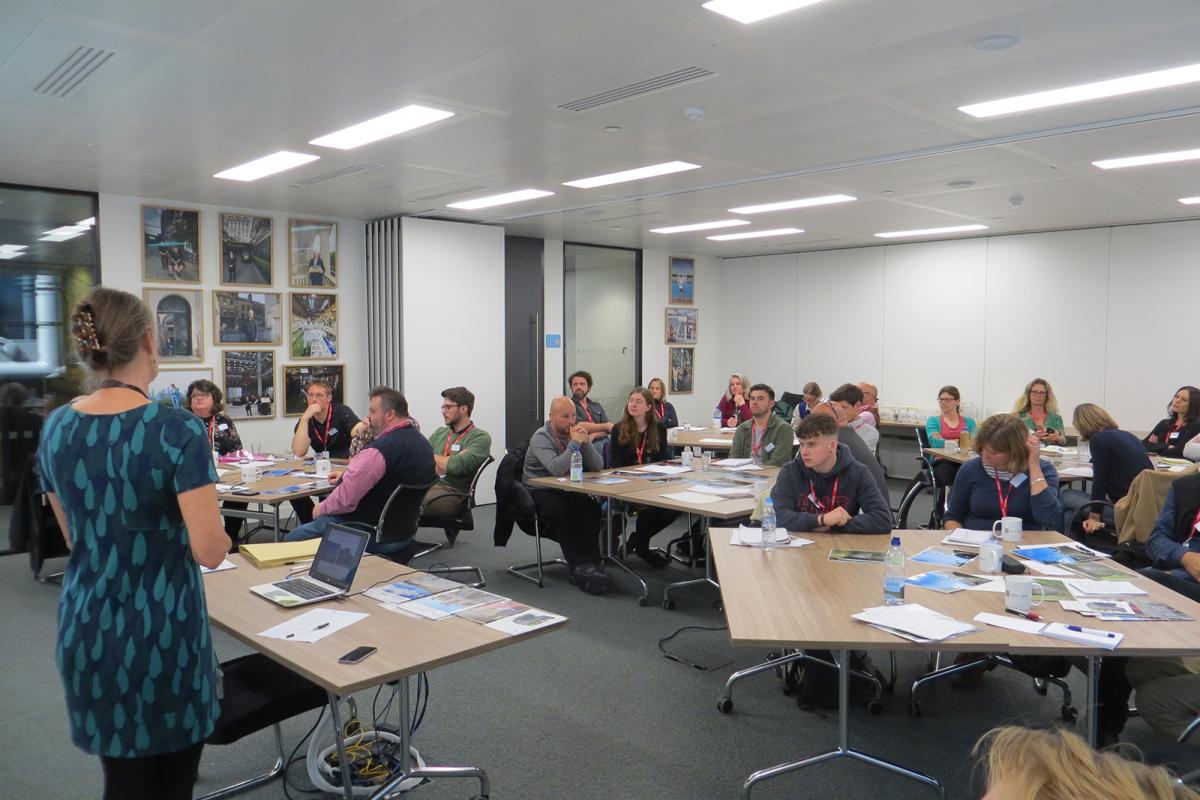It is useful sometimes to take time out to think about what you are doing and why you are doing it, as well as to hear the latest thoughts on a subject. That was the benefit of this heritage CPD from Historic England.
Stone Federation Great Britain members have provided plenty of continual professional development (CPD) about the use of stone for architects, but last month it was the turn of the Federation’s members to receive a CPD in stone conservation, restoration and repair from the experts of Historic England. And what a worthwhile CPD it was.
Historic England delivered its first one-day presentation on stone conservation, restoration & repair in February as part of the Stone Federation Professional Practice Programme for NVQ Level 3. It proved so successful that the event was held again in May, this time as a CPD independent of the NVQ. More are planned for the future. Those who attended the first two certainly recommend the event.
The CPD in May was an informative and enjoyable day that many on the conservation side of stonework would certainly have found useful, just as those who took part reported they had. It would be beneficial for any company working in conservation / restoration signing up for the future courses that are promised.
The day was run by Alison Henry, Head of Building Conservation & Geospatial Survey at Historic England, and Senior Architectural Conservator Clara Willett. Both had been at the Natural Stone Show in London the week before, where Historic England had its own conservation area and conference programme as part of the exhibition.
 Lunchtime views of London from the Cannon Bridge House roof garden.
Lunchtime views of London from the Cannon Bridge House roof garden.
The Historic England training day was held at the organisation’s offices on the fourth floor of Cannon Bridge House, next to the Thames in London. A lunch break gave those on the course a treat in being able to stroll in the sunshine on the building’s rooftop garden, with its vantage point views of Tower Bridge on one side and St Paul’s Cathedral on the other.
Claire Wallbridge, Stone Federation Great Britain’s Training Manager, who also manages the Natural Stone Industry Training Group, had arranged the event. She told the 26 people there (most from the stone industry, although six of Historic England’s own people also came along) that the day would remind them of some essential aspects of stone conservation and introduce them to some new ideas, which the feedback at the end indicated it had.
In the normal day-to-day hustle and bustle of work it is sometimes easy just to get on with it. A day out can provide a useful opportunity to stand back and re-focus on what lies behind conservation of the built heritage.
Hats off to both Alison Henry and Clara Willett for maintaining a high level of interest throughout a day that packed in a lot of information. They involved their audience in exercises and discussions to keep it lively and interactive and to help lessons stick.
Those from the stone industry came from companies that included Szerelmey, Recclesia, Pierra, Forest of Dean Stone Firms, Sally Strachy Historic Conservation, Stone Restoration Services, Aura, Sandberg and Re-Vive.
Tim Yates, the Stone Federation’s immediate past-president (he had passed on the chain of office at the Natural Stone Show to Marcus Paine of Hutton Stone) stood in for Bernard Burns, who chairs the Federation’s Heritage Forum, to welcome those who attended the course. Bernard was unable to make it.
 Alison Henry presenting part of the CPD.
Alison Henry presenting part of the CPD.
Alison began by explaining the division of English Heritage and Historic England, with English Heritage intended to become an independent, self financing charity to look after historic properties and sites, and Historic England being the body that advises government on the country’s built heritage (as opposed to its natural heritage) and historic monuments.
These days, econometrics come into play in deciding the value of a heritage building or site by ascribing it a value that goes beyond what it can be sold for or rented at.
It might be considered to have additional value because it helps create a sense of place or define regional diversity. It might have archaeological, or evidential value based on how it has been used previously and, sometimes, who has used it.
With stone, that might include tooling on the surface, indicating which tools had been used and how they had been used in creating the masonry or architectural detail. That can give a building an historical value in showing how people lived in the past.
Buildings can demonstrate technological innovations that might be important in the development of architecture. Iron frames of buildings, for example. Early examples of such construction methods illustrate innovation in building construction.
Who has lived in a house might also impact on its heritage value. An example given by Alison was the homes of the influential 1960s band The Beatles. The essentially ordinary homes the four men of the band grew up in take on a special significance simply because those four men lived in them.
Old buildings might also be considered to have particular artistic or aesthetic value. “All these different values we add up to determine the significance of the building,” said Alison. “We can say these are the values that matter.”
This ‘significance’ explains why buildings should be looked after and conserved and is encapsulated in the British Standard 7913, Guide to the Conservation of Historic Buildings.
That does not mean such buildings should be preserved in aspic. Alison: “We expect that through history things do change and have changed. But we should be trying to manage that change so we don’t change the values we have assigned to the building. This is the significance-based approach.”
Having decided a building has a heritage significance, it is then necessary to determine the threats to that significance, which might be from the decay of materials used to build it or might just as easily come from somebody’s desire to demolish or significantly alter it.
Threats are not only faced by the historic building itself, either. The significance of a building might include the landscape or buildings that surround it, which contribute to its sense of importance, perhaps. Building next to it, especially if the new structure overshadows it, might alter that sense of importance.
Having identified the threats, it is necessary to develop a strategy to tackle them without endangering the significance of the building. “Conservation is a process of managing change,” said Alison.
One of the most overlooked aspects of conservation is maintenance. Buildings are quite often damaged simply because gutters are not mended or buddleia growing out the masonry is not removed.
Even if a building is maintained, there will come a time when materials used in its construction need repairing and eventually a building might have to be restored, although Alison said unpicking a building and trying to return it to its original condition is not really good conservation practice because often the changes that have been made to an old building in the course of its existence are part of its significance.
She spoke about the legislation protecting heritage, such as the scheduling of ancient monuments and the listing of properties, pointing out that although Grade I and Grade II* properties tend to have higher profiles, 91.7% of all listed properties are Grade II. And while estate agents might say only parts of a building are listed, Alison reminded those on the CPD that a listing always covers the whole of a building.
After an exercise determining the significance of structures in photographs, it was Clara’s turn. She started with a brief history of the use of stone in construction as far back as Stonehenge and long barrows for burials.
She pointed out that stone used for construction before the building of canals and railways would usually have been won from a site extremely close to the building it was used to construct because nobody wanted to move stone long distances. That could mean the stones used were not ideal building stones. After canals, railways and eventually roads started to be used to transport stone, better building stones, such as Portland and Bath Stone, were used more widely.
While stone tends to be a generally durable building material, it does eventually weather and decay and Clara addressed some of the mechanisms of deterioration, including mechanical stresses such as point loading and thermal expansion and contraction leading to cracking.
Chemical stresses can be caused by the wetting and drying out of clays in stones, which can lead to failures, as can the migration of salts, which manifest as efflorescence.
The effects of sulphur in the atmosphere turn limestone (Calcium carbonate) into calcium sulphate, or magnesium limestone into magnesium sulphate, making the masonry dirty in sheltered areas where the rain does not wash away the accumulated sulphur deposits.
With sandstone, it is the reverse, with washed areas tending to become dirty and protected areas staying clean.
Identifying which areas are dirtiest is a quick guide to whether the building is constructed of sandstone or limestone.
In coastal areas, sodium chlorate coming off the sea can cause decay of stone, as can the migration of water up and down a wall or the failure of stone to dry out, perhaps because it is in contact with vegetation. Bird droppings are another source of contamination and decay.
Sometimes even the way the stone has been used can accelerate its decay, perhaps because it has not been used on-bed or because the mortar used is harder than the stone and the migration of moisture is restricted, so a stone remains wet. Clara said pointing should be sacrificial and deteriorate so that the stone does not.
Back to Alison and the crucial phase in conservation of assessment; deciding what exactly has happened and is happening to the stone and determining what needs to be done about it. “I have seen a lot of specifications where the people writing them don’t even know whether they are dealing with limestone or sandstone. You have to understand the cause of the problems.”
She mentioned ways of researching a building – looking through archives, finding photographs, surveying the building, testing materials. Seeing what repairs have been carried out previously can be instructive. “If one particular element keeps needing repair it’s an indication that there’s an underlying problem.”
A survey should include the context of the building – its location, whether it is sheltered or exposed, its proximity to trees, other buildings and roads, the ground it is standing on and how well that drains.
“Drainage is hugely under-appreciated,” said Alison. “It’s one of the biggest problems faced by old buildings.” And that is not just exterior drainage, water can be leaking from interior plumbing.
A lot of decay is related to moisture, often trapped moisture, but it is important to determine where that moisture is coming from. Rising damp is often blamed for damp walls where the culprit is the occupants simply breathing and causing condensation. “Condensation can be very aggressive, as well as causing mould, which is not nice to live with,” said Alison.
There can even be different causes of deterioration on walls facing in different directions, as well as micro-climates leading to specific areas of deterioration, perhaps as the result of wind tunnelling effects. This had happened at York Minster, where decay occurred just above the roof levels of neighbouring buildings as a result of wind channelling.
Determining the cause of decay is the start of treating it appropriately. There are clues. Alison said if stone is crumbling that is symptomatic of salt erosion, whereas if it is flaking it is likely to be frost damage.
And an important part of assessing a building is determining what is changing now. Many old buildings have minimal foundations, which can lead to subsidence or bulges. But if the movement happened 200 years ago and it has been stable ever since an intervention might not be the right course of action.
“When you see a crack or a bulge you want to do something about it, but we would say: first monitor it,” said Alison. And ‘monitoring’, she said, should take place over at least a year because a crack that opens up in a dry summer might close again in a wet winter in response to the building moving with ground conditions.
“The thing is not to panic.”
Attitudes towards conservation have changed over time and are, perhaps, becoming more flexible now than at some times in the past. Mortar examination, for example, can be over-egged, according to Alison. Throughout history builders would have used whatever was available and she suggested sometimes trying accurately to reproduce a mortar down to the last ingredient would be a pointless exercise. “Just use your eyes,” she said. “Crumble a bit in your fingers.”
She said mortar would probably have been replaced by multiple repointings in an old building and even the original mortar probably changes a lot throughout the building. “People send off a tiny bit of mortar for analysis and use that analysis to specify a replacement. I get very angry when that happens. I think it’s nonsense and likely to cause problems.” Historic England has developed detailed mortar tables that require those using them to think about what they are trying to achieve.
Cleaning is another common cause of debate in conservation. Clients might want to end up with a building that looks new, but achieving that can lose some of the historical significance of the structure. On the other hand, dirt can be harmful to the fabric of a building, said Clara.
She said it was important to decide what level of clean would be appropriate and manage client expectations about what will be achieved. “It’s really important to do trials,” she said. That applied to whatever method of cleaning was to be used. Alison added: “It’s also a good way of determining how long it’s going to take.”
Consolidants have traditionally been frowned on in the UK, although there is a more relaxed attitude towards them on the Continent. Perhaps the conservation sector in the UK is having second thoughts about them, but “if you’re thinking you can stick stone back together again you’re asking a lot of these products”, said Alison. Nevertheless, Historic England had been surprised how well consolidants used in the 1990s had worked and how well they had lasted. “We think we need to be more explorative about this.” The same was true of water repellants.
They discussed shelter coats, lime washes, renders and whether replacement stonework should try to follow the original lines or blend in more with weathered stone.
During their presentations, Alison and Clara gave a number of tips for identifying problems such as those mentioned above. The problems, their possible causes and methods for dealing with them have been set out in a series of books available from Historic England under the general title of Practical Building Conservation followed by a subject.
Practical Building Conservation: Stone was published in 2012. It has 350 pages, is well illustrated and can be bought from Routledge for £82.99. It is one of 10 books in the series.
Pictured below: Those taking part in the CPD on the roof garden of Cannon Bridge House overlooking the Thames with Tower Bridge in the background.


